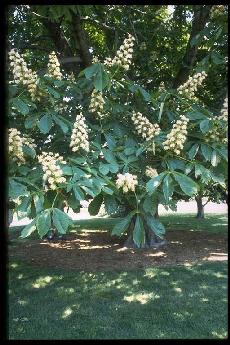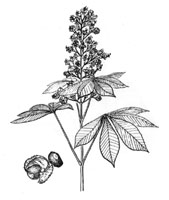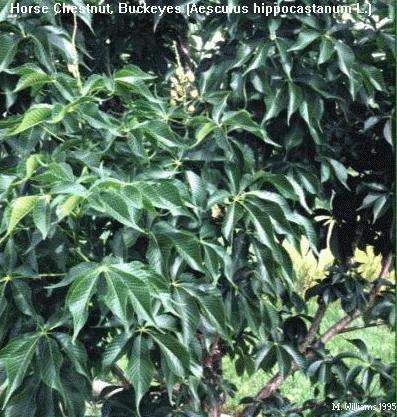OHIO BUCKEYE HORSECHESTNUT
Aesculus glabra Aesculus hippocastanum


(horsechestnut family)
TOXICITY RATING: Moderate to high.
ANIMALS AFFECTED: All animals may be affected, especially grazing animals and those consuming the honey.
DANGEROUS PARTS OF PLANT: Buds, nuts, leaves, bark, seedlings, and honey.
CLASS OF SIGNS: Two effects: gastrointestinal and neurologic: excessive salivation, gastrointestinal irritation, vomiting in those species that can vomit, abdominal pain, diarrhea. Neurologic signs can include staggering, trembling, breathing difficulty, dilated pupils, collapse and paralysis, which can proceed to coma and death.
PLANT DESCRIPTION: The thick twigs of these medium-sized trees have glistening buds in spring and bear opposite leaves composed of five leaflets in a finger-like arrangement (fig. 44). The yellowish flowers rise in large, upright, dense, candle-like clusters at branch ends during June. The prickly fruit contains 1 to 3 nutlike seeds, glossy and leathery brown with a pale scar on each that gives the tree its name. These trees commonly grow in rich, moist woods or along river banks and are often planted as ornamentals.
SIGNS: The toxins in Buckeye and Horsechestnut affect the gastrointestinal tract as well as the nervous system. The saponic glycoside aesculin in addition to suspected alkaloids cause the toxic signs. Initially, gastrointestinal signs manifest, which can include salivation, vomiting (in those species that can vomit), abdominal pain, and diarrhea. If enough was ingested, neurologic signs may develop, including trembling, staggering, and difficulty in breathing. Toxicity may then progress to collapse, paralysis, coma and death.
These trees are among the first to leaf out in the spring, and hungry animals on pasture may be tempted to eat them if no other forages are available.
FIRST AID: If animals are observed eating Ohio Buckeye or Horsechestnut, contact a veterinarian immediately; emergency measures can be used to remove plant material from the digestive tract. Once clinical signs are present, and if it has been several hours after the plants were consumed, supportive care is all that can be provided, since there is no antidote for this toxicosis.
SAFETY IN PREPARED FEEDS: Reports are unclear concerning the safety of Ohio Buckeye or Horsechestnut in processed feeds. Therefore, in the interest of safety, consider these plants as toxic and do not feed processed feeds if contaminated.
PREVENTION: If animals are to be pastured with these trees, be certain that adequate, nutritious forage is available. In this way, the animals are likely to avoid consuming toxic quantities of these trees.
![]()

![]()
 Wildflower
Seed For Sale
Wildflower
Seed For Sale